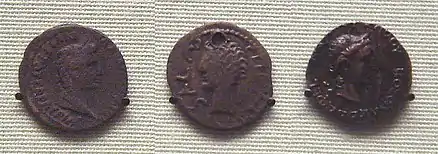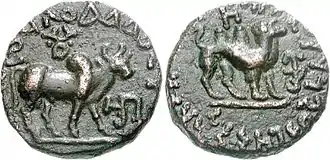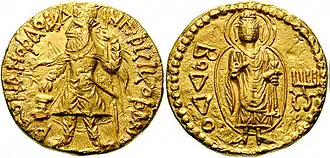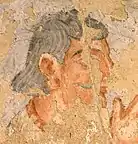Kujula Kadphises
Kujula Kadphises (Kushan language: Κοζουλου Καδφιζου, also Κοζολα Καδαφες; Kharoṣṭhī: Kujula Kasasa; Ancient Chinese: 丘就卻, Qiujiuque; reigned 30–80 CE, or 40-90 CE according to Bopearachchi[1]) was a Kushan prince who united the Yuezhi confederation during the 1st century CE, and became the first Kushan emperor. According to the Rabatak inscription, he was the great grandfather of the great Kushan king Kanishka I. He is considered the founder of the Kushan Empire.[1]
| Kujula Kadphises | |||||
|---|---|---|---|---|---|
| Kushan emperor | |||||
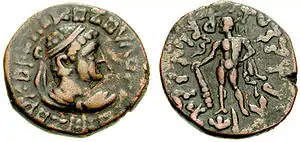 Tetradrachm of Kujula Kadphises (30-80 CE) in the style of Hermaeus. | |||||
| Reign | January 27, 30 CE - November 7, 80 CE | ||||
| Predecessor | Heraios | ||||
| Successor | Cagaragus | ||||
| Born | 4 BCE Herat, Afghanistan | ||||
| Died | November 7, 80 CE Multan, Pakistan | ||||
| Burial | |||||
| Spouse | Arphratres | ||||
| Issue | Cagaragus | ||||
| |||||
| House | Kujulids | ||||
| Dynasty | Kushan | ||||
History
The origins of Kujula Kadphises are quite obscure, and he is usually believed to be a descendant of the Kushan ruler Heraios, or possibly identical with him.[2] However, Kujula shares his name (Kushan: Κοζουλου on some of his "Hermaeus" coins, or Κοζολα on his "Augustus" coins) with some of the last Indo-Scythian rulers, such as Liaka Kusulaka (Greek: Λιακα Κοζουλο), or his son Patika Kusulaka, which might suggest some family connection.[3]
Chinese accounts
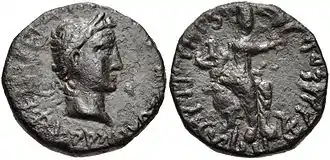
Obv Laureate Julio-Claudian style head right. Greek legend Greek legend around: ΚΟΖΟΛΑ ΚΑΔΑΦΕϹ XOPANOV ZAOOV.
Rev Kujula Kadphises seated right, raising hand; tripartite symbol to left. Legend Khushanasa Yauasa Kuyula Kaphasa Sacha Dhramatidasa.
In the process of their expansion eastward, Kujula Kadphises and his son Vima Takto (or Vema Tahktu) seem to have displaced the Indo-Parthian kingdom, established in northwestern India by the Parthian Gondophares since around 20 CE:
His son, Yangaozhen [probably Vema Tahktu or, possibly, his brother Sadaṣkaṇa], became king in his place. He defeated Tianzhu [North-western India] and installed Generals to supervise and lead it. The Yuezhi then became extremely rich. All the kingdoms call [their king] the Guishuang [Kushan] king, but the Han call them by their original name, Da Yuezhi [Great Yuezhi].[4]
The invasion of the Indo-Parthian kingdom led by Kujula Kadphises is thought to have occurred some time after 45 CE, during the reign of Gondophares's successors: Abdagases and Sases.
Genealogy according to the Rabatak inscription
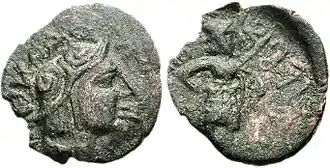
The connection of Kujula with other Kushan rulers is described in the Rabatak inscription, discovered in Rbatak, Afghanistan some years ago, which was written by Kanishka. Kanishka makes the list of the kings who ruled up to his time: Kujula Kadphises as his great-grandfather, Vima Taktu as his grandfather, Vima Kadphises as his father, and himself Kanishka:
And he [Kanishka] gave orders to make images of the same, (namely) of these gods who are written herein, and he gave orders to make (them) for these kings: for King Kujula Kadphises (his) great grandfather, and for King Vima Taktu (his) grandfather, and for King Vima Kadphises (his) father, and for himself, King Kanishka.[5]
Coinage
The coinage of the Kushan ruler, Kujula Kadphises, shows us the enlargement of the religious horizon of the Kushans. His first issue, which has the debased portrait and name of Hermaeus on the obverse, shows Heracles on the reverse, still following the Greek tradition, even though Heracles may be the interpretatio Graeca of the Iranian god Verethragna. Contrary to earlier assumptions, which regarded Kujula Kadphises as Buddhist on the basis of the epithet of the 'satyadharmasthita' epithet, it is now clear from the wording of a Mathura inscription, in which Huvishka bears the same epithet satyadharmasthita , that the kingdom was conferred upon him by Sarva (Shiva) and Scamdavira (Candavlra), that is, he was a devotee of the Hindu God Siva. It is striking to see that Kujula Kadphises has already adopted the worship of Siva and the use of Kharosthï script at such an early date. [6]
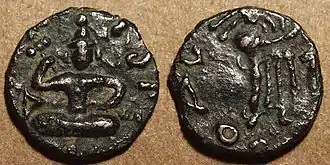
Obv Kujula seated cross legged facing, Kharoshti legend: Kuyula Kadaphasa Kushanasa.
Rev Zeus on the reverse, Greek legend: ΚΟΖΟΛΑ XOPANOY ZAOOY.
References
| Kushan Empire 30 CE–350 CE | ||||||||||||||||||||||||||||||
|---|---|---|---|---|---|---|---|---|---|---|---|---|---|---|---|---|---|---|---|---|---|---|---|---|---|---|---|---|---|---|
|
||||||||||||||||||||||||||||||
- Osmund Bopearachchi, 2007, Some observations on the chronology of the early Kushans
- Cribb, J. (1993), The Heraus coins: their attribution to the Kushan king Kujula Kadphises, c. AD 30-80. Essays in Honour of Robert Carson and Kenneth Jenkins, (edited by M. Price, A. Burnett, and R. Bland), London, 107-134.
- Rapson, "Indian coins of the British Museum", p.cvi
- Hill (2009), p. 29.
- Sims-Williams' "provisional translation" quoted in Hill (2009), p. 592.
- History of civilizations of Central Asia. Dani, Ahmad Hasan., Masson, V. M. (Vadim Mikhaĭlovich), 1929-, Harmatta, J. (János), 1917-2004., Puri, Baij Nath., Etemadi, G. F., Litvinskiĭ, B. A. (Boris Anatolʹevich). Paris: Unesco. 1992–2005. p. 318. ISBN 92-3-102719-0. OCLC 28186754.CS1 maint: others (link) CS1 maint: date format (link)
Bibliography
- "Catalogue of coins in the Panjab Museum, Lahore. Vol. I Indo-Greek coins", Whitehead, Argonaut Inc. Publishers, Chicago.
- Chavannes, Édouard (1907). Les pays d'occident d'après le Heou Han chou. T’oung pao 8. pp. 149-244.
- Hill, John E. 2004. The Western Regions according to the Hou Hanshu. Draft annotated English translation.
- Hill, John E. (2009). Through the Jade Gate to Rome: A Study of the Silk Routes during the Later Han Dynasty, First to Second Centuries CE. BookSurge. ISBN 978-1-4392-2134-1.
External links
| Preceded by Heraios (Gandhara, Punjab) |
Kushan Ruler 30 – 80 CE |
Succeeded by Heraios (as Kushan King) |
| Preceded by Vima Takto (as Indo-Parthian king) |
- From the dated inscription on the Rukhana reliquary
- An Inscribed Silver Buddhist Reliquary of the Time of King Kharaosta and Prince Indravarman, Richard Salomon, Journal of the American Oriental Society, Vol. 116, No. 3 (Jul. - Sep., 1996), pp. 442
- A Kharosthī Reliquary Inscription of the Time of the Apraca Prince Visnuvarma, by Richard Salomon, South Asian Studies 11 1995, Pages 27-32, Published online: 09 Aug 2010
- Cribb, Joe; Donovan, Peter (2014). Kushan, Kushano-Sasanian, and Kidarite Coins A Catalogue of Coins From the American Numismatic Society by David Jongeward and Joe Cribb with Peter Donovan. p. 4.
